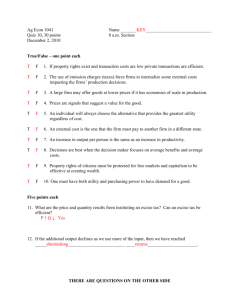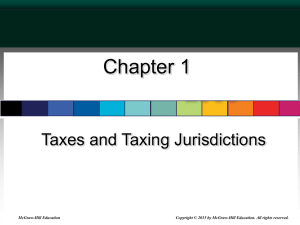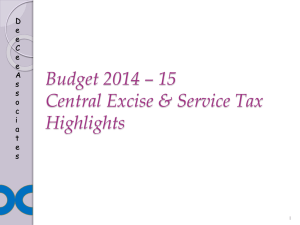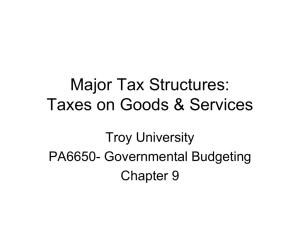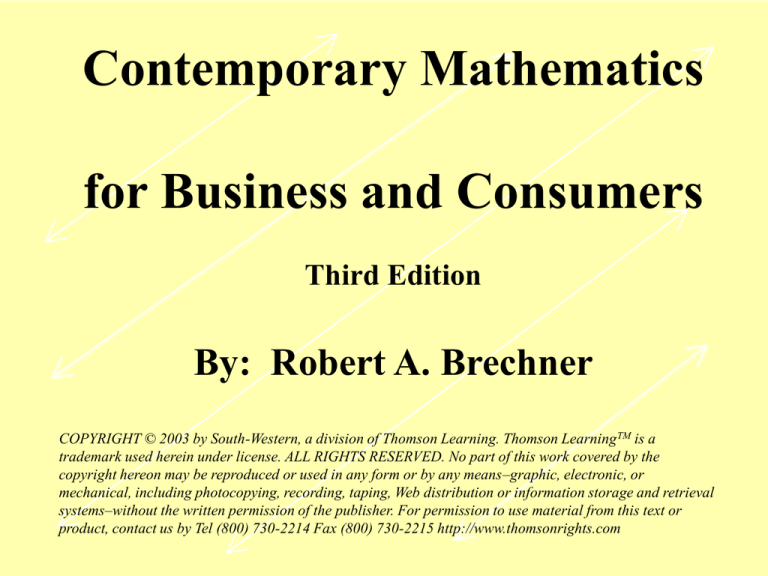
Contemporary Mathematics
for Business and Consumers
Third Edition
By: Robert A. Brechner
COPYRIGHT © 2003 by South-Western, a division of Thomson Learning. Thomson Learning TM is a
trademark used herein under license. ALL RIGHTS RESERVED. No part of this work covered by the
copyright hereon may be reproduced or used in any form or by any means–graphic, electronic, or
mechanical, including photocopying, recording, taping, Web distribution or information storage and retrieval
systems–without the written permission of the publisher. For permission to use material from this text or
product, contact us by Tel (800) 730-2214 Fax (800) 730-2215 http://www.thomsonrights.com
Chapter 18
Taxes
Copyright © 2003 by South-Western
Chapter 18, Taxes
Section I Sales Tax and Excise Tax
18-1 Determining sales tax by using sales tax tables.
18-2 Calculating sales tax by using the percent method.
18-3 Calculating selling price and amount of sales tax
when total purchase price is known.
18-4 Calculating excise tax.
Section II Property Tax
18-5 Calculating the amount of property tax
18-6 Calculating tax rate necessary in a community to meet
budgetary demands.
Section III, Income Tax (Cont.)
18-7 Calculating taxable income for individuals.
18-8 Using the Tax Table to determine tax liability.
18-9 Using the Tax Rate Schedule to determine
tax liability.
18-10 Calculating an individual’s tax refund or
amount of tax owed.
18-11 Calculating corporate income tax and net
income after taxes.
Section I, Sales Tax and Excise Taxes
18-1 Determining Sales Tax by Using Sales
Tax Tables
Steps to Determine Sales Tax Due on an Item by
Using Sales Tax Tables:
Step 1. Locate the taxable retail price in the
Amount of Sale column.
Step 2. Scan to the right to locate the amount of
tax due in the Tax Column.
Everybody’s Business
Currently, 45 states have sales tax, with
rates that range from 3% to 8%. In many
areas, city and county rates add an
additional .5% to 6%.
States with the highest sales tax rates are
Tennessee, Alabama, Mississippi, and
Missouri. Among the lowest are Vermont,
Massachusetts, Maryland, Indiana, and
Iowa.
18-2 Calculating Sales Tax by Using the percentage
Method
Steps to Determine Sales Tax and Total Price by Using the
Percent Method
Step 1. Calculate the sales tax by multiplying the selling
price of the good or service by the sales tax rate:
Sales tax = Selling price x Sales tax rate
Step 2. Compute the total purchase price by adding the
selling price, the sales tax, and any other additional
charges.
Total purchase price = Selling price + sales tax + Other charges
18-3 Calculating Selling Price and Amount of Sales
Tax When total Purchase Price is Known
Steps to Calculate Selling price and Amount of Sales Tax
Step 1. Calculate the selling price of an item by dividing
the total purchase price by 100% plus the sales rate::
Selling price = Total purchase price
100% +Sales tax rate
Step 2. Compute the total purchase price by adding the
selling price, the sales tax, and any other additional
charges.
Sales tax = Total purchase price - Selling price
Everybody’s Business
The government “takes its cut” is a good
description of the excise or tax charged on
various goods considered luxury items.
The word excise is from excidere, Latin for
“to cut out.” In essence, the government
cuts out its share!
In 2000, the federal government collected
$54.8 billion in excise tax.
Everybody’s Business
Don’t tax the tax! The excise tax is not
included in the selling price when
computing the sales tax. Each tax should be
calculated separately on the actual selling
price.
Section II, Property Tax
18-5 Calculating the Amount of Property Tax
Steps to Calculate Property Tax When the Tax is Expressed
as a Percent:
Step 1. Convert the tax rate percent to a decimal by
moving the decimal point 2 places to the left.
Step 2. Multiply the assessed value by the tax rate as a
decimal.
Property tax = Assessed value x Tax rate
Everybody’s Business
Property taxes vary greatly from area to
area. Among the highest are Lansing
Michigan; Buffalo, New York; Jersey City,
New Jersey; Providence, Rhode Island; and
Milwaukee, Wisconsin.
Among the lowest are Honolulu and Hilo,
Hawaii; Mobile, Alabama; Baton Rouge.
Louisiana; and Colorado Springs, Colorado.
Section III, Income Tax
18-7 Calculating Taxable Income for Individuals
Steps to Calculate Taxable Income for Individuals:
Step 1. Determine total income by adding all sources of taxable
income.
Step 2. Calculate adjusted gross income by subtracting the sum of all
adjustments to income from total income.
Step 3. Subtract the sum of the itemized deduction or the standard
deduction (which ever is larger) from the adjusted gross income.
Step 4. If adjusted gross income is $99,725 or less:
Multiply $2,900 by the total number of exemptions claimed and
subtract from the amount in Step 3. The result is taxable income.
If adjusted gross income is over $99,725:
See IRS instructions to find the exemption amounts.
Everybody’s Business
There are three basic rules to folow when
doing taxes to avoid arousing the IRS
suspicion.
1. Don’t Be Greedy
2. Don’t be Sloppy
3. Don’t “Forget” Income
Everybody’s Business
A qualifying domestic corporation with 35
or fewer shareholders may elect to be
treated as an S-corporation, for federal
income taxes.
Instead, any taxable income or loss will be
allocated proportionately among the
shareholders, who will be responsible for
reporting the amounts on their personal
income tax returns.
Chapter 18, Taxes
Taxation
Sales tax rate
Property tax
Personal property
Fair market value
Property appraiser
Tax return
Tax Table
Tax credit
Corporate Tax Rate Schedule
Sales tax
Excise tax
Real estate
Assessed value
Tax assessor
Income tax
Taxable income
Tax Rate Schedules
Useful life
Chapter 18
Sales and Excise Taxes
Sales tax = Selling price x Sales tax rate
Total purchase = Selling price + Sales tax + Other charges
Price
Selling price =
Total purchase price
100% + Sales tax rate
Sales tax = Total purchase price - Selling price
Copyright © 2003 by South-Western
Chapter 18
Sales and Excise Taxes continued
Excise tax = Selling price x Excise tax rate
Excise tax = Number of units x Excise tax rate
Total purchase price = Selling price + Sales tax + Excise tax
Copyright © 2003 by South-Western
Chapter 18
Property Tax
a. Expressed as a Percent
Property tax = Assessed value of property x Tax rate
b. Expressed per $100 of Assessed Value
Property tax = # of $100 of assessed value x Tax per $100
c. Expressed per $1,000 of Assessed Value
Property tax = # of $1,000 of assessed value x Tax per $1,000
d. Expressed in Mills
Tax rate in decimal form = Tax rate in mills x .001
Property tax = Assessed value x Tax rate in decimal form
Copyright © 2003 by South-Western
Chapter 18
Community Tax Rate
Tax rate per
=
dollar (decimal form)
Total taxes required
Total assessed property value
Income Tax
Refund (-) or amount owed (+) =
Tax liability - Credits + Other taxes - Payments
Copyright © 2003 by South-Western

